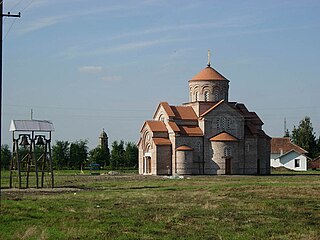
Plandište is a village and municipality located in the South Banat District of the autonomous province of Vojvodina, Serbia. The village has a population of 3,832, while Plandište municipality has 11,336 inhabitants. One of municipality's best known landmarks is Kapetanovo Castle, located in Stari Lec.

Banatsko Aranđelovo is a village located in the Novi Kneževac municipality, in the North Banat District of Serbia. It is situated in the Autonomous Province of Vojvodina. The village has a Serb ethnic majority (53.08%) with a present Hungarian (26.54%) and Romani minority (15.13%). It has a population of 1,718 people.

Bašaid is a village located in the Kikinda municipality, in the North Banat District of the Republic of Serbia. It is situated in the Autonomous Province of Vojvodina. The village has an ethnic Serb majority (89.15%) and a population of 3,503. Administratively, the settlement of Bikač is also classified as part of Bašaid.

Đurđevo is a village located in the Žabalj municipality, in the South Bačka District of Serbia. It is situated in the Autonomous Province of Vojvodina. The village has a Serb ethnic majority and a population numbering 5,137 people. Besides Serbs, the village also has a large Rusyn minority.

Gajdobra is a village located in the Bačka Palanka municipality, in the South Bačka District of Serbia. It is situated in the autonomous province of Vojvodina. Gajdobra has a total population of 2,578 inhabitants. Most of the inhabitants of the village are ethnic Serbs.
Filić is a village located in the Novi Kneževac municipality, in the North Banat District of Serbia. It is situated in the Autonomous Province of Vojvodina. The village has a Serb ethnic majority (60.24%) with a significant Hungarian minority (38.50%). It has a population of 161 people.

Velika Greda is a village in Serbia. It is situated in the Plandište municipality, in the South Banat District, Vojvodina province. The village has a Serb ethnic majority (69,86%) with a present Hungarian (12.29%) and a Macedonian minority (9.89%), and its population as of the 2002 census, was 1,374 people.
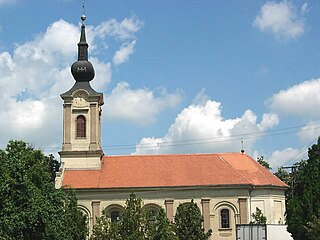
Ostojićevo is a village in Serbia. It is situated in the Čoka municipality, North Banat District, Vojvodina province. The village has a Serb ethnic majority (56.15%) with a present Hungarian minority (26.51%) and its population numbering 2,844 people. The village also has a Polish minority of about 300 people, of Cieszyn Silesian descent.

Stari Lec is a village in Serbia. It is situated in the Plandište municipality, in the South Banat District, Vojvodina province. One of Stari Lec's best known landmarks is Kapetanovo Castle.
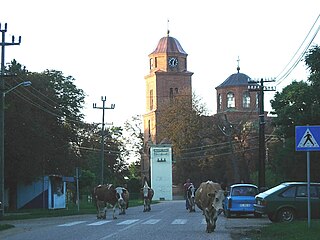
Veliko Središte is a village in Serbia. It is situated in the Vršac municipality, in the South Banat District, Vojvodina province.

Sutjeska is a village in Serbia. It is situated in the Sečanj municipality, in the Central Banat District, Vojvodina province. The village has a Serb ethnic majority (60.21%) and a sizable Romanian minority (28.26%) and a population of 1,737 people.

Grabovo is a village in Serbia. It is situated in the Beočin municipality, in the Vojvodina province. Although, the village is geographically located in Syrmia, it is part of the South Bačka District. The village has a Serb ethnic majority. The population of the village, numbering 138 people according to a 2002 census, is steadily declining and the village is in danger of disappearing.

Montenegrins of Serbia are a recognized national minority in Serbia. According to the 2022 census, the population of ethnic Montenegrins in Serbia is 20,238, constituting 0.3% of the total population. The vast majority of them live in Vojvodina and Belgrade.
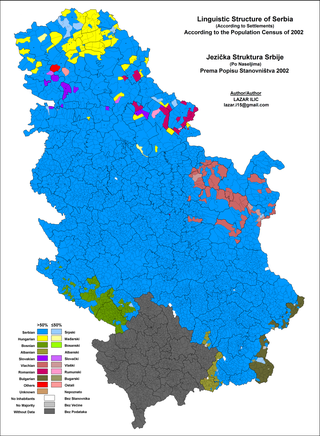
Serbia has only one nationwide official language, which is Serbian. The largest other languages spoken in Serbia include Hungarian, Bosnian and Croatian. The Autonomous Province of Vojvodina has 6 official languages: Serbian, Hungarian, Slovak, Romanian, Croatian, Rusyn; whilst Autonomous Province of Kosovo and Metohija, which Serbia claims as its own, has two: Albanian and Serbian.

Krčedin is a village in Serbia. It is situated in the Inđija municipality, in the Srem District, Vojvodina province. The village has a Serb ethnic majority and its population numbering 2,878 people. Great fishing and hunting place. It has the biggest natural island on all Danube river, Krčedinska Ada.
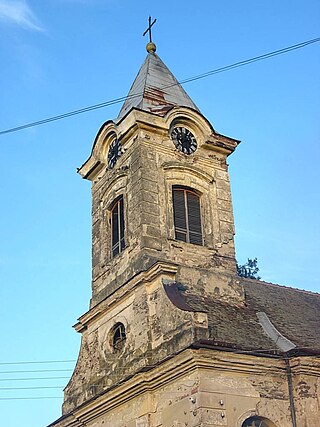
Gudurica is a village in Serbia. It is situated in the Vršac municipality, in the South Banat District, Vojvodina province. The village has a Serb ethnic majority (66.21%) and a sizable ethnic Macedonian minority (10.49%), and its population numbering 1,092 people. Part of the Macedonians of Gudurica are in fact assimilated Aromanians and specially Megleno-Romanians that came to the village from the Macedonian SR it following the expulsion of its native German population.

Hajdučica is a village in Serbia. It is situated in the Plandište municipality, in the South Banat District, Vojvodina province. The village is ethnically mixed and its population numbering 1,375 people, including 579 Slovaks (42,10%), 419 Serbs (30,47%), 159 Hungarians (11,56%), 123 Macedonians (8,94%), and others.
Laudonovac is a village in Serbia. It is situated in the Plandište municipality, South Banat District, Vojvodina province. The village has a Serb ethnic majority (66.66%) with a present Romanian (16.66%) and Macedonian (8.33%) minority. Its population numbering 24 people.

Markovićevo is a village in Serbia. It is situated in the Plandište municipality, South Banat District, Vojvodina province.

Macedonians in Serbia are a recognized national minority in Serbia. According to the 2022 census, the population of ethnic Macedonians in Serbia is 14,767, constituting 0.2% of the total population. The vast majority of them live in Belgrade and Pančevo.





















